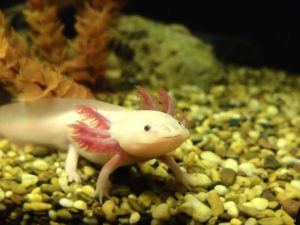Joshua Rapp Learn in Smithsonian:
 When Lake Xochimilco near Mexico City was Lake Texcoco, and the Aztecs founded their island capital city of Tenochtitlan in 1325, a large aquatic salamander thrived in the surrounding lake. The axolotl has deep roots in Aztec religion, as the god Xolotl, for whom the animal is named, was believed to have transformed into an axolotl—although it didn’t stop the Aztecs from enjoying a roasted axolotl from time to time. The custom of eating axolotl continues to this day, although the species has become critically endangered in the wild. Saving the salamander that Nature called “biology’s beloved amphibian” takes on a special significance given the animal’s remarkable traits. Axolotls are neotenic, meaning the amphibians generally do not fully mature like other species of salamander, instead retaining their gills and living out their lives under water as a kind of juvenile. On rare occasions, or when stimulated in the lab, an axolotl will go through metamorphosis and develop lungs to replace its gills.
When Lake Xochimilco near Mexico City was Lake Texcoco, and the Aztecs founded their island capital city of Tenochtitlan in 1325, a large aquatic salamander thrived in the surrounding lake. The axolotl has deep roots in Aztec religion, as the god Xolotl, for whom the animal is named, was believed to have transformed into an axolotl—although it didn’t stop the Aztecs from enjoying a roasted axolotl from time to time. The custom of eating axolotl continues to this day, although the species has become critically endangered in the wild. Saving the salamander that Nature called “biology’s beloved amphibian” takes on a special significance given the animal’s remarkable traits. Axolotls are neotenic, meaning the amphibians generally do not fully mature like other species of salamander, instead retaining their gills and living out their lives under water as a kind of juvenile. On rare occasions, or when stimulated in the lab, an axolotl will go through metamorphosis and develop lungs to replace its gills.
Accompanying these unique traits is a remarkably complex genome, with 32 billion base pairs compared to about 3 billion base pairs in human DNA. The axolotl has the largest genome ever fully sequenced, first completed last year by a team of European scientists. The University of Kentucky, which heads axolotl research in the United States, today announced that researchers have added the sequencing of whole chromosomes to the European effort—“about a thousand-fold increase in the length of assembled pieces,” according to Jeremiah Smith, an associate biology professor at the University of Kentucky. Scientists hope to use this new data to harness some of the axolotl’s unique abilities.
More here.
